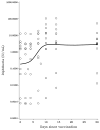Antibody response to booster vaccination with tetanus and diphtheria in adults exposed to perfluorinated alkylates
- PMID: 26181512
- PMCID: PMC4739630
- DOI: 10.3109/1547691X.2015.1067259
Antibody response to booster vaccination with tetanus and diphtheria in adults exposed to perfluorinated alkylates
Abstract
Recent studies suggest that exposure to perfluorinated alkylate substances (PFASs) may induce immunosuppression in humans and animal models. In this exploratory study, 12 healthy adult volunteers were recruited. With each subject, serum-PFAS concentrations were measured and their antibody responses prospectively followed for 30 days after a booster vaccination with diphtheria and tetanus. The results indicated that serum-PFAS concentrations were positively correlated and positively associated with age and male sex. The specific antibody concentrations in serum were increased from Day 4 to Day 10 post-booster, after which a constant concentration was reached. Serum PFAS concentrations showed significant negative associations with the rate of increase in the antibody responses. Interestingly, this effect was particularly strong for the longer-chain PFASs. All significant associations remained significant after adjustment for sex and age. Although the study involved a small number of subjects, these findings of a PFAS-associated reduction of the early humoral immune response to booster vaccination in healthy adults supported previous findings of PFAS immunosuppression in larger cohorts. Furthermore, the results suggested that cellular mechanisms right after antigen exposure should be investigated more closely to identify possible mechanisms of immunosuppression from PFAS.
Keywords: Antibodies; immunotoxicity; perfluorinated alkylate substances; prospective study; vaccinations.
Conflict of interest statement
The authors report no conflicts of interest. The authors alone are responsible for the content of this manuscript.
Figures



References
-
- Corsini E, Sangiovanni E, Avogadro A, et al. In vitro characterization of the immuno-toxic potential of several perfluorinated compounds (PFCs) Toxicol Appl Pharmacol. 2012;258:248–255. - PubMed
-
- DeWitt JC, Peden-Adams MM, Keller JM, Germolec DR. Immunotoxicity of perfluorinated compounds: Recent developments. Toxicol Pathol. 2012;40:300–311. - PubMed
-
- Dietert RR. Developmental immunotoxicology: Focus on health risk. Chem Res Toxicol. 2009;22:17–23. - PubMed
Publication types
MeSH terms
Substances
Grants and funding
LinkOut - more resources
Full Text Sources
Medical
